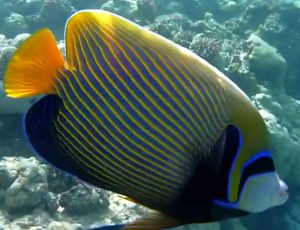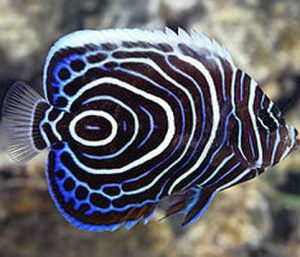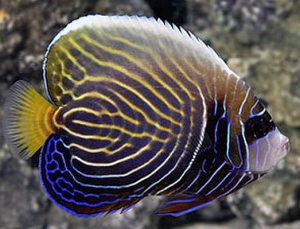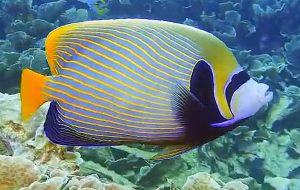The Emperor Angelfish (Pomacanthus imperator) known to tropical fish keeping enthusiasts as Imperial Angelfish or Imperator Angelfish is found in the Indo and Central Pacific Oceans from the coasts of East African and the Red Sea to the Tuamotu, Line Island chain and infrequently around the Hawaiian Islands southward to New Caledonia, and north to southern Japan to the Great Barrier Reef.
Being indigenous to both the Indian and Pacific Oceans, the Emperor Angelfish is prized for it’s regal electric royal blue and bright yellow colors however, they are not considered reef safe.
Although juvenile Emperor Angelfish are normally solitary, adults are gregarious and often found in small harems around coral rich tropical reefs and patch reefs at depths from 60 to over 200 feet, where they spend their time grazing on on algae, sponges and tunicates.
Juvenile Pomacanthus imperator have a deep blue black base color with white concentric circles, a white dorsal fin margin, and a transparent caudal fin.
Adult Emperor Angelfish have thin yellow and blue alternating stripes along the flanks that start behind the gills and end at the base of the caudal fin, a greenish yellow nape, a dark black mask over the eyes outlined in bright blue, and a light bluish white snout. The dorsal fin is edged in white, the caudal fin is a bright yellow, and the anal fin has light blue stripes along a dark blue background edged in bright baby blue.
Juveniles begin to transform into their adult colors when they are around 3 to 5 inches in length. At this stage they
are sometimes misidentified as juvenile queen angelfish (Holacanthus ciliaris) and blue angelfish (Holacanthus bermudensis) which have bright blue body bars. Juvenile French angelfish (Holacanthus paru) and gray angelfish (Holacanthus arcuatus) have bright yellow body bars on a black body background.
Juvenile Emperor Angelfish should be housed in a large stable mature reef aquarium of at least 125 gallon capacity with plenty of live rock with algae and sponge growth for them to graze upon and arranged into overhangs, caves, and large crevices for them to hide amongst. If you plan on keeping a pair, increase the tank volume to at least 180 gallons.
Although Pomacanthus imperator are known to feed on soft and stony corals and nip at clam mantles, they are less likely to consume SPS corals and will often ignore many corals entirely. The safest corals to keep with this species is bubble corals, disc anemone, hammer corals, star polyps, and small polyped stony corals.
Plenty of mature live rock, preferably with a lot of sponge growth as a food source, is essential for Emperor Angelfish; as is pristine water quality for them to thrive. Because they produce a large amount of waste, a strong filtration system and regular water changes is needed for the tank.
Although Emperor Angelfish will tolerate pretty much any water flow, they do better in slower moving currents. Strong reef lighting is recommended for this species not only to display their coloration, but because they are prone to parasitic infestations, to avoid diseases.
A single adult Emperor Angelfish should be housed in a mature reef aquarium of at least a 250 gallon capacity, with plenty of live rock for grazing. The rockwork should be arranged into caves, overhangs, and crevices for hiding places, yet with plenty of free swimming space.
Adult Emperor Angelfish are extremely territorial towards members of their own species and tend to bully and eat smaller fish of any species. They can be housed with other similarly natured larger species, with care.
Emperor Angelfish are omnivores that in their natural habitat feed on small crustaceans, algae, soft and stony corals, and sponges.
In an aquarium environment, they will eat live, frozen, and freeze dried marine foods, vitamin enriched brine shrimp, Krill, Spirulina, marine algae, OSI flakes, mysis or frozen shrimp, fresh chopped shrimp, squid, octopus, and mollusks.
Because sponge is a primary nutrient source for this species in nature; a varied diet that includes frozen a prepared food for marine angelfish that include sponges is highly recommended, especially for juveniles raised in captivity that often display unidentified nutritional deficiencies.
These angels are not recommended for the amateur saltwater aquarist.
The Emperor Angelfish (Pomacanthus imperator) is one of the more expensive saltwater species and tropical fish keeping enthusiasts can expect to pay anywhere from $85 to over $325 dollars for a specimen depending on size and level of maturity.
Minimum Tank Size: 125 gal to 250 gal
Aquarium Type: Deepwater Reef
Care Level: Moderate to Difficult
Temperament: Moderately Aggressive
Aquarium Hardiness: Hardy when acclimated
Water Conditions: 72-82°F, dKH 8 to 12, pH 8.1-8.4, sg 1.020-1.025
Max. Size: 15″
Color Form: Black, Yellow, Blue, White
Diet: Omnivore
Compatibility: Reef Compatible with caution
Origin: Africa, Fiji, Indonesia, Maldives, Sri Lanka
Family: Pomacanthidae
Lifespan: Up to 20 years
Aquarist Experience Level: Advanced






